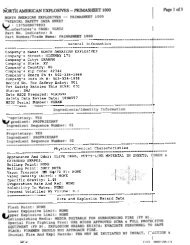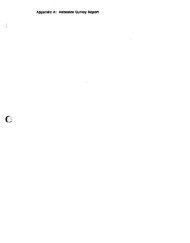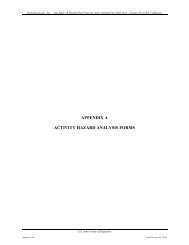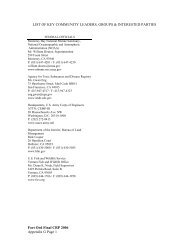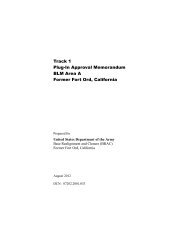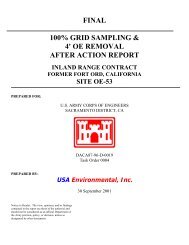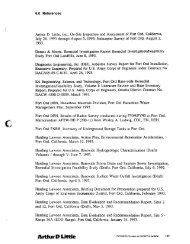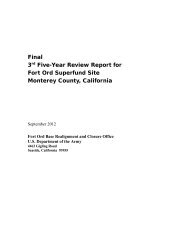Final Second Five-Year Review Report Fort Ord Superfund Site ...
Final Second Five-Year Review Report Fort Ord Superfund Site ...
Final Second Five-Year Review Report Fort Ord Superfund Site ...
You also want an ePaper? Increase the reach of your titles
YUMPU automatically turns print PDFs into web optimized ePapers that Google loves.
Confirmation <strong>Report</strong> and Post-Remediation Health Risk Assessment, <strong>Site</strong> 12 Remedial Action, Basewide<br />
Remediation <strong>Site</strong>s, <strong>Fort</strong> <strong>Ord</strong>, California (IT, 1999c). The soil remediation resulted in the site being<br />
available for unrestricted reuse.<br />
Groundwater Remedy<br />
A groundwater pump and treat system was constructed in 1999 to remediate the plume of COCs in<br />
groundwater. During the operation of the treatment system, sampling and analysis are conducted to<br />
verify that the treatment system is operating effectively. Since 1999, water samples and water levels from<br />
groundwater MWs have been collected every three months. This information has been compiled into<br />
quarterly and annual reports to show the long-term trends resulting from system operation.<br />
The groundwater treatment system originally consisted of carbon adsorption, accomplished using two<br />
13,000-pound carbon vessels connected in series. The original system extracted water from eight wells<br />
located at <strong>Site</strong> 12 and discharged into five Upper 180-Foot Aquifer recharge structures (2 injection wells<br />
and 3 infiltration galleries). After startup, system modifications were immediately implemented due to<br />
the presence of vinyl chloride concentrations greater than anticipated. System modification included<br />
construction of a pipeline to transport and combine treated water from OU 2 with treated water from <strong>Site</strong><br />
12 prior to conveyance to the aquifer recharge structures. Most recently, an air stripper has been added<br />
for treatment of vinyl chloride (Section 7.1.2.4).<br />
7.1.2.3 System Operations and Maintenance<br />
The <strong>Site</strong>s 2/12 groundwater treatment system has been in operation since April 1999.<br />
The <strong>Site</strong>s 2/12 groundwater remedy is operated in accordance with the Operation and Maintenance,<br />
Groundwater Treatment Systems, Former <strong>Fort</strong> <strong>Ord</strong>, California (Harding ESE/IT, 2001a) and Sampling<br />
and Analysis Plan, Operable Unit 2, and <strong>Site</strong>s 2 and 12 Groundwater Treatment Systems, Former<br />
<strong>Fort</strong> <strong>Ord</strong>, California (AGSC, 2004). O&M activities are summarized annually in treatment system data<br />
summary reports. The most recent annual report describing <strong>Site</strong>s 2/12 O&M is the Annual Groundwater<br />
Treatment Systems Operation Data Summary <strong>Report</strong>, January through December 2005, Operable Unit 2<br />
and <strong>Site</strong>s 2/12, Former <strong>Fort</strong> <strong>Ord</strong>, California (AGSC, 2007). To date, the system has processed over 884<br />
million gallons of water and removed over 334 pounds of contaminants, of which approximately 75.8<br />
percent is TCE, cis-1,2-DCE, 1,1-DCA, PCE, and chloroform. The system operates continuously except<br />
for periods of routine maintenance, carbon servicing, and replacement of worn equipment, and has been<br />
operational approximately 95.5 percent of the time. Carbon replacement in the system has occurred<br />
approximately every 4 to 6 months since operation began.<br />
7.1.2.4 Progress Since the last <strong>Five</strong>-<strong>Year</strong> <strong>Review</strong><br />
In February 2002, the Army received Regulatory Agency approval to temporarily increase the maximum<br />
discharge level for vinyl chloride to the State of California MCL of 0.5 μg/L. The RI <strong>Site</strong>s ROD<br />
(Army, 1997b) lists the discharge limit and aquifer cleanup level for vinyl chloride as 0.1 μg/L. In<br />
February 2003, the discharge level was revised to 0.3 μg/L and was effective until June 2006. The<br />
elevated discharge limit for vinyl chloride allowed the groundwater treatment system to be operated<br />
closer to the initial individual well design flow capacity.<br />
The pilot study evaluating the effectiveness of in-situ chemical oxidation of vinyl chloride using<br />
potassium permanganate was completed in 2002. In addition to the pilot study, an evaluation of various<br />
remediation alternatives and approaches was also conducted. The treatment augmentation recommended<br />
in the Engineering Design and Analysis <strong>Report</strong> (Shaw, 2005b) consists of a modified low profile air<br />
stripper, with vapor treatment by a substrate impregnated with potassium permanganate. Since the<br />
<strong>Final</strong><br />
7-4<br />
FORMER FT ORD 5YR REVIEW 2007_FINAL United States Department of the Army



